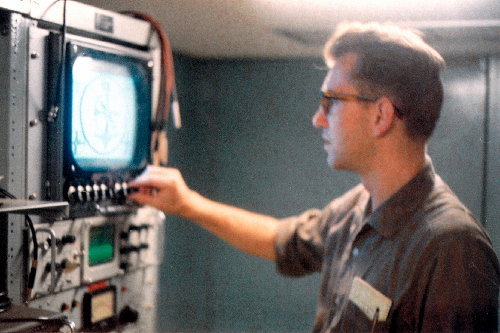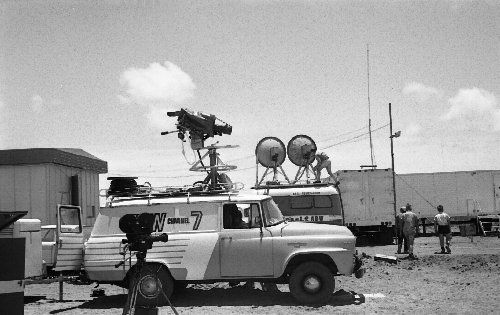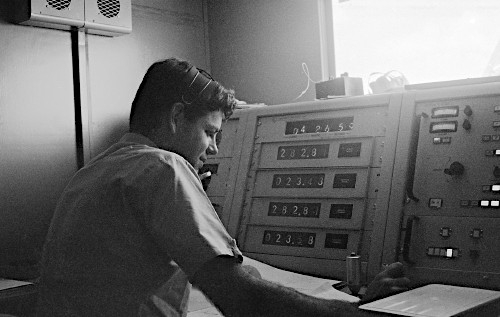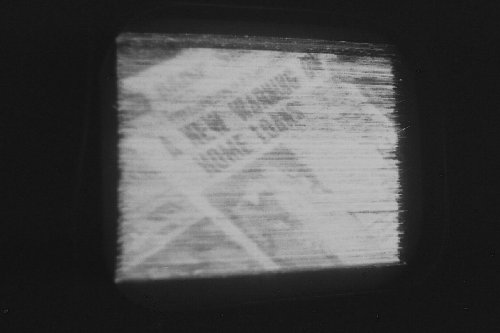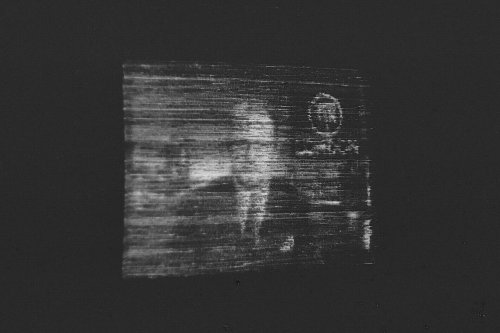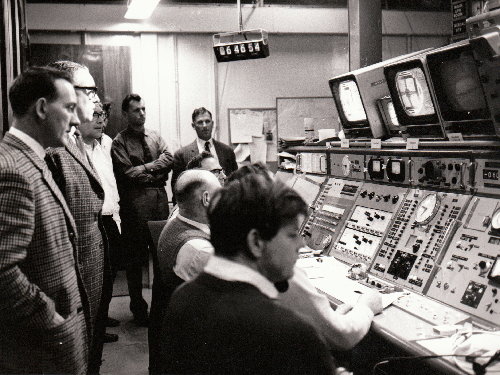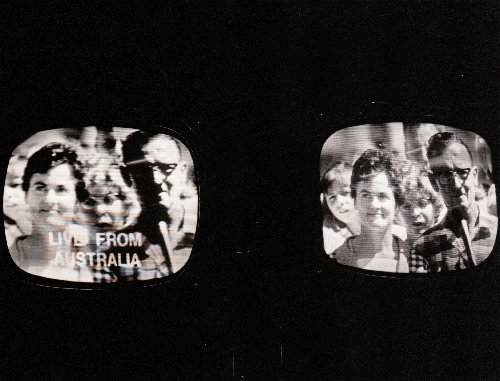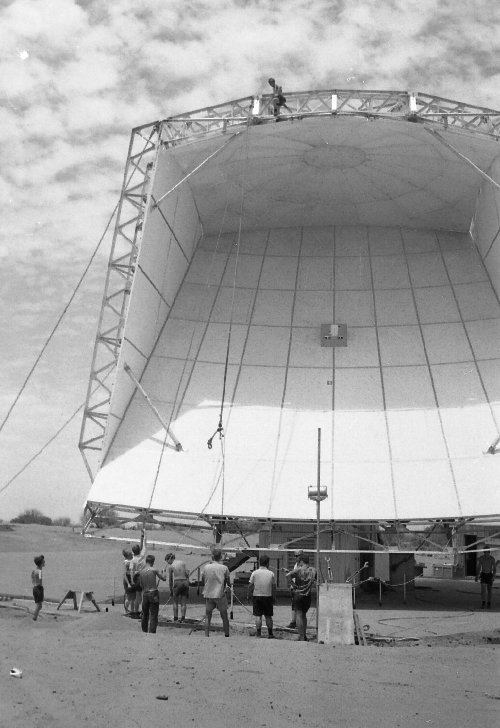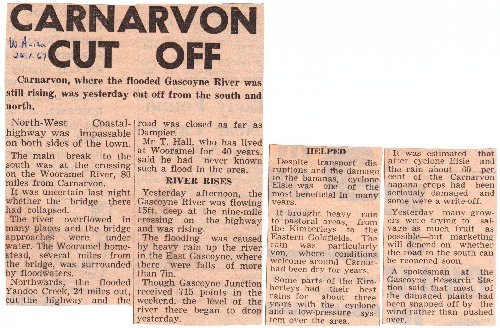OTC (Australia) Engineer Guntis Berzins at Carnarvon in 1966.
Establishment of the OTC(A) Carnarvon Earth Station
and the Historic
Carnarvon – Goonhilly TV Broadcast
by
Guntis (“Gus”) Berzins
OTC (Australia) Engineer Guntis Berzins at Carnarvon in 1966. |
Background
As part of its space programme the United States National Aeronautics and Space Administration (NASA) in 1963 established a Tracking Station on Brown Range, about 10 km outside Carnarvon. Subsequently, the USA embarked on Project Apollo, the project to put a man on the moon, and great emphasis was then placed on security, including security and reliability of communications.
With communications via satellite becoming technically feasible, and in order to enhance security, NASA developed a plan to connect its principal overseas tracking stations via satellite communications links with the various control centres in the USA. To implement this plan NASA intended to let a contract for the provision and operation of the satellites, earth stations and all other necessary facilities to the Communications Satellite Corporation (Comsat), an entity established by the US Government in 1962 for developing satellite communications.
The plan envisaged the establishment in twelve months from October 1965 of three satellite earth stations in the USA (Brewster Flat, Washington State; Andover, Maine and Hawaii) and at three non-US locations – Ascension Island and the Canary Islands in the Atlantic and Carnarvon in Western Australia. However, OTC(A), as Australia’s international telecommunications operator and Cable and Wireless as the telecommunications operator for the U.K. overseas territories (including Ascension Island) made it clear that under their national telecommunications laws Comsat would not be permitted to establish and operate commercial telecommunications facilities in their territories and insisted that they should be the operators of the planned earth stations. Telefonica of Spain, as the responsible operator for Spanish territories later joined this stance.1
OTC(A) thereby took on the responsibility of providing an earth station in Carnarvon, to be ready for service by October 1966. Given this very short time scale, and since Comsat had already developed a specification for a transportable earth station including a folded cassegrain horn (“sugar scoop”) antenna, OTC(A) essentially specified a similar station and let the contract to the same company as Comsat – Northrop Page Communications Corp. This was to be Australia’s first satellite communications earth station; the first of many.
To provide the satellites for the system required by NASA, Comsat had negotiated an agreement with Hughes Aircraft Company for the development and construction of four satellites, based on the successful experimental “Early Bird” satellite (later renamed “Intelsat I”), which had allowed early tests of satellite communications over the Atlantic, between the USA, UK, France and Germany. These were drum shaped satellites, with the drum covered with solar cells and the communications antenna projecting from one end. Since the antenna radiated a doughnut shaped beam, the satellite had to be correctly orientated toward the earth for maximum strength signals and this stability was achieved by the gyroscopic effect of spinning the satellite. The satellites were to be place in a geostationary orbit, i.e. an orbit about 36,000 km above the earth in which they essentially appeared to be stationary above the same point on the equator.
Although Comsat had negotiated the agreement for these satellites, they proposed that ownership and operation of the satellites be taken over by the “International Telecommunications Satellite Organisation” (Intelsat), an intergovernmental organisation established in 1964 to provide international telecommunications by satellite. Although the organisations was established by governments, the shareholders (so called “Signatories”) were in most cases the countries’ telecommunication entities. Comsat was the US Signatory as well as the Manager for the organisation whilst OTC(A) was Australia’s signatory. Intelsat took over responsibility for the satellites and they were duly named Intelsat II, with the initial satellite to be launched for Pacific service.
Preparing the Carnarvon Earth Station for Service
In February 1966, as a relatively young engineer, I was appointed to the position of “Senior Engineer” in OTC(A)’s Planning Department to be part of the team planning the establishment of the Carnarvon Earth Station. This appointment put me into the then very new field of satellite communications, which was personally both a most interesting and challenging job. As a result, during 1966, I attended meetings in London, Washington and Madrid, as well as Sydney, in which the organisations owning the earth stations for the NASA communications network agreed on various aspects of operating and maintaining the network. Whilst in Washington I also visited Page Communications, to observe and discuss progress in construction of the earth station equipment.
To prepare for operating the earth station, it was necessary to select staff who would man the station as well as provide training courses for them, since satellite communications was a totally new field for OTC(A) and it did not have any staff with experience in this field. Consequently we not only selected staff from our various other stations, but also tried to find technicians from outside OTC(A) who had some experience in this field.
In September 1966 OTC(A) transferred me to their Operations Branch and I was designated to be the on-site engineer responsible for acceptance testing of the Carnarvon Earth Station, i.e. testing to ensure that Page Communications had met the defined specifications, and in general for commissioning the earth station to be ready for service. In carrying out these duties I was in Carnarvon from the 29 September 1966 until 9 February 1967 and was assisted by Donald (Don) Kennedy, who was an Engineer Grade II at the time and stayed in Carnarvon about the same length of time. He now lives in the UK.
The Station Manager of the OTC(A) Carnarvon Earth Station at the time it was established was Leo Mahoney, a worldly wise personality with extensive experience and technical knowledge, who was assisted by the Deputy Station Manager Jack Gray a good humoured man with long technical experience. The technicians on the station had been selected to be young and capable of absorbing this new technology and comprised Terry Etherington, Jim Harte, Roy Hunt, Terry Nipperess, Al Pilgrim and Tony Wallbridge, and Senior Plant Officer Dave Reynolds.
Carnarvon earth station staff, OTC(A) Head Office engineers and Page Communications engineer. Photo probably taken January 1967. Front row, from left: Guntis (Gus) Berzins (OTC(A) Head Office engineer responsible for acceptance testing of earth station, Roy Hunt (OTC(A) technician), Al Pilgrim (OTC(A) technician), Terry Etherington (OTC(A) technician), Dave Williams? (Page Communications engineer from USA), Back row, from left: Tony Wallbridge (OTC(A) technician), Dave Reynolds (Senior Plant Officer), Jim Harte (OTC(A) technician), Don Kennedy (OTC(A) Head Office engineer), Jack Grey (Deputy Station Manager), Terry Nipperess (OTC(A) technician), Leo Mahoney (Station Manager). 19670100004_6 |
At the time I arrived in Carnarvon most of the equipment was in place and the construction was substantially complete and the emphasis was on getting the equipment and the whole station operating. The main building and the power house had been constructed, the transportable vans were in place, the folded cassegrain antenna had been constructed and the staff houses were close to completion.
Houses under construction on Browns Ridge for OTC(A) earth station personnel – October 1966. My wife Laima and I lived in one of these houses whilst I was posted to Carnarvon. 19661000001_2 |
In addition a “boresight tower” had been erected in a field on the far side of the Gascoyne, some kilometres from the earth station, sited precisely north. The boresight transmitted a signal, which simulated the tracking signal from the satellite.
The earth station equipment, although not necessarily state-of-the-art in all aspects, nevertheless in some areas was quite demanding and station staff had to be quite proficient to understand how the equipment functioned, how to maintain it and how to repair it when it failed. Most of the equipment was located in three transportable vans – Operations, Maintenance and Power van provided by Page Communications. The main receiver was a parametric amplifier, certainly a state-of-the-art device at the time whose operation depended on being cooled to 17°K by a special gaseous helium refrigeration system to achieve the requisite sensitivity. For transmitting the station had two power amplifiers that used water cooled klystrons and could deliver 12 KW of RF power.
The folded cassegrain antenna had an aperture of about 13 metres square and consisted of two reflector surfaces, a parabola and hyperbola, which required very precise alignment to achieve the design antenna performance. The antenna was on a mount, which moved in azimuth and elevation (“az-el mount”) and was driven by a hydraulic control system. It could be steered in three modes – by following a tracking signal from the satellite, by “programme tracking” using data received by telex from Comsat and recorded on punched paper tape, or thirdly, purely manually by moving a joystick on the control panel. The tracking system was fast and powerful and could turn the 25 ton antenna at a speed of 5° per second and the effect of using the joystick to simultaneously turn the antenna horizontally and raise it in elevation gave the appearance of the antenna screwing into the sky. Needless to say such an extreme manoeuvre was not required to track geostationary satellites and was simply a demonstration of the antennas capability, and sometimes resulted in blown power fuses.
The earth station’s cassegrain horn antenna. The upward pointing feed horn, from which signals were transmitted and received can be seen in the middle of the main parabolic. The reflector at the top was a hyperbolic shape reflector. The antenna had an azimuth and elevation tracking mount. 19670100004_3 |
The earth station was planned to provide seven voice/data circuits to the USA, one of which was subdivided to give three telegraph circuits. In addition, there was a separate orderwire circuit. To pass the communications and tracking, telemetry and command signals to and from the NASA Tracking Station at Carnarvon, the earth station was connected to it by means of duplicate telephone cables laid on Browns Range. The station was connected to the Carnarvon town power supply, but it also had two emergency power systems in the event of problems with the town supply. The whole earth station, including equipment, buildings and staff housing had cost OTC(A) about $3 million.
During October and November 1966 the Page Communications engineers from the USA, with the assistance of the station staff were getting the equipment operational and lining it up. However, there were many difficulties – with the antenna tracking system, with the power amplifiers (transmitters), the parametric amplifiers and the emergency power system. A note of humour was added by the Post Office in Sydney, who readdressed our mail to the “OTC Satellite Faith Station”, an address we thought aptly captured the mood during this period.
Launch of Intelsat II-F1 satellite
The Intelsat II-F1 satellite, which was due to be placed above the Pacific Ocean and used for Carnarvon – USA communication, was launched on 26 October 1966. In a letter dated 30 October I wrote: “The construction of our station is considerably behind time but the Americans are trying hard to more or less get it ready for service. For the first two days after the satellite launch we tried to receive the satellite signals but without success, but on Saturday (29 October 1966) we finally received the signals and everyone was very elated”. My diary entry for 29 October reads: “Satellite first acquired between 1130am and 1200 am” (probably should have read “1200pm”).
Communications satellites are positioned in a circular geostationary orbit by having the launch rocket initially place them in a long elliptical orbit, called the transfer orbit, whose apogee (highest point) is at the same height as the geostationary orbit. Following orbital calculations and after some time in the transfer orbit, a small solid fuel rocket motor built into the satellite called, the “apogee kick motor” is fired when the satellite is at its apogee to place it in the circular geostationary orbit.
Unfortunately, when the apogee kick motor was fired on Intelsat II-F1, the motor nozzle blew off and the satellite remained in an orbit similar to the transfer orbit. So, although the communications functions in the satellite worked perfectly, it was useless for its intended purpose as it was not stationary above the Pacific, as required, but rather precessed around the earth in its elliptical orbit. From our viewpoint, failure of the satellite was probably fortunate, as we kept having various difficulties with the earth station and in reality it was far from being operational. Nevertheless the satellite, even in its errant orbit, could be used on an intermittent basis for testing the earth station.
My diary entries record the following significant events:
12 Nov. 1966: “Acquired satellite and for the first time looped signals through it, using a power of about 4KW. This occurred around 0400 GMT”.
13 Nov. 1966: “ Established first contact between Carnarvon and an overseas station (Hawaii) at 22.21 GMT (12th Nov.) Initial contact was by o/w (voice) but later communications carriers were also transmitted and received. Antenna initially tracked successfully on autotrack but later autotrack suddenly failed and manual tracking was required”.
Historic Carnarvon – Goonhilly TV transmission – 25 November 1966
Transmission of TV by satellite had been demonstrated in the early 1960’s across the Atlantic via the Telstar satellite and across the Pacific in 1964 between Japan and USA with the Relay satellite. OTC(A) had designated Cyril Vahtrick, an engineer by profession and one of its senior management staff, to examine and lead the development of satellite communications by the organisation. As a result of the overseas demonstrations he recognised the public importance and impact of making a TV transmission between Australia and overseas. He also recognised that the impending launch of the Intelsat II-F1 satellite provided an opportunity to attempt a TV link between Australia and the UK, using the Carnarvon earth station.2
It was intended to establish the Australia-UK link-up by transmitting the TV signals to the Brewster Flat earth station in the USA, carrying the signals terrestrially across the USA and using a trans-Atlantic satellite link to reach the UK. This had the added complication that the originated TV signal in Carnarvon would have to be the US NTSC 525 line standard.
Some time before the satellite launch date, a team of ABC engineers arrived in Carnarvon and together with the Page on-site engineers we worked out the necessary arrangements to hook up the ABC outside broadcasting equipment with the earth station. Presumably via OTC(A) Head office we also agreed on the detailed engineering arrangements with Goonhilly. Consequently, five days after the satellite was launched, on 31 October 1966 two OTC(A) engineers – Jim Robertson and Ken Howe – arrived in Carnarvon from Head Office in Sydney together with the necessary additional video equipment. However, this was also the day when the apogee motor was fired on the satellite to place it into geostationary orbit. Unfortunately, the motor failed and the satellite remained in a highly elliptical orbit.
Nevertheless, the next day, according to my diary, the ABC proceeded to set up their outside broadcasting equipment, which had come by road from Perth. To link-up with Goonhilly, one of the upconverter/downconverter sets, of which the earth station had two, had to be retuned to the common frequencies agreed for the transmission, leaving the other set available for testing with the USA. Even though the satellite was not available, it was possible to loop the transmit and receive directions of the earth station and demonstrate that the TV transmission worked back-to-back. In my diary I recorded: “surprisingly good results”.
News of the possible TV transmissions was known in Carnarvon and there was a general air of expectancy and excitement. However, after some days, recognising that the TV transmission was put back for an indefinite time, the ABC people departed and the town was again its usual quiet.
After some days the orbit of the errant satellite had been recalculated and tests confirmed that communications wise it operated satisfactorily. Furthermore, its new but unplanned orbit was such that until 26 November, for some hours each day, it would be visible from both Carnarvon and Goonhilly, the earth station in the UK, after which there would be no mutual visibility for a lengthy period. Consequently OTC(A) Head Office again considered that the TV link-up with Goonhilly should be attempted. Calculations indicated that such a transmission would be feasible towards the UK, because Goonhilly had a large antenna, which could easily receive the TV transmission from the satellite, but would be marginal from the UK towards Carnarvon, because its antenna was considerably smaller and hence the received signals would be weaker.
All would have been well but the earth station continued to experience one problem after another and, after taking stock of the situation, I telexed OTC(A) Head Office on 21 November recommending “that no engineering tests be performed with Goonhilly during this mutual visibility period” only to receive a reply the next morning “TV transmission Carnarvon – Goonhilly scheduled for 25 November”. So much for recommendations! Fortunately, thanks to the efforts of Page engineers and the station staff, the earth station was made more or less operational in the next days and preparatory testing for the TV transmissions commenced at 14.00 local time on 23 November, with a loop TV transmission through the satellite. As predicted by calculations, the picture quality (as recorded in my diary) was “very noisy”.
The next day we tested with Goonhilly, exchanging TV test patterns and pictures from 0530 to 0700 UTC (13.30 to 15.00 local) and my diary says: “Received picture very noisy, but Goonhilly receives good picture”. The testing with Goonhilly was coordinated via a telephone circuit, which had been set up using the Compac submarine cable.
Test signals received from Goonhilly probably before the actual Carnarvon – Goonhilly broadcast on 25 November. The text “Goonhilly Radio Station” is faintly visible in the monitor. (See the same test card here.) 19661125001_4 |
On the day of the actual broadcasts, 25 November 1966, there was a general air of expectancy and excitement, both at the earth station and in Carnarvon itself. There were ABC and Channel 7 vehicles and staff at the earth station and the ABC had set up a temporary microwave link for relaying signals between the earth station and the town.
Australian Broadcasting Commission (ABW2) links van and TVW Channel 7 small one-camera outside broadcast van at the OTC(A) earth station – 25 November 1966. The dishes are for the temporary microwave link set up by the ABC to connect the ABW2 multi-camera outside broadcast van in Carnarvon with the earth station. 19661125001_6 |
Although initially arrangements for the broadcasts had been only with the ABC, at some stage Channel 7 indicated that they wished to be involved. The station staff had equipped one of the station’s rooms with TV monitors for viewing the broadcasts by VIPs, station staff and wives.
For the transmissions we had agreed that Don Kennedy would man the control panel and primarily ensure correct pointing of the antenna, whilst I was in the rear of the Operations van, together with a number of other OTC(A), Page and ABC staff observing the TV quality on the monitor and liaising with Goonhilly over the coordination circuit.
OTC(A) engineer Don Kennedy monitoring precise tracking of the satellite from the earth station’s tracking console during the TV transmissions. Pointing of the antenna was controlled from this console. The time shown on the console is 4 26 59, i.e. 4.26 UTC or 12.26 local time. 19661125001_7 |
The received signal was continually being monitored in the Carnarvon station, so that even whilst transmitting towards Goonhilly, we were receiving and monitoring the video signal as looped through the satellite and we could see when there was a deterioration in the quality, principally due to the antenna not tracking the satellite precisely.
Engineers and technicians viewing the historic TV transmission. The engineer in the chequered shirt in the front was Dave Williams from Page Communications. On the left is OTC(A) technician Al Pilgrim. 19661125001_14 |
At the UK end, the broadcasts to and from the ABC were passed from Goonhilly to the BBC studios, whilst the broadcasts to and from Channel 7 to the ITV studios. There were a total of four broadcasts, i.e. each pair of organisations (ABC – BBC and Channel 7 – ITV) sent and received broadcasts from the other.
The ABC broadcast consisted of interviews of a group of British staff who worked at the NASA Tracking Station in Carnarvon. They spoke to their relatives in a BBC studio in London and described their lives and some showed their children to the great delight of their relatives in London. The interviews took place on the main street in Carnarvon and the ABC also showed scenes of Carnarvon and people describing life in the town. The broadcast was in real-time, spontaneous and interesting, and is described in detail in a recently published book.3
In the return broadcast towards Australia, the BBC showed the eminent scientist Sir Bernard Lovell, who talked about the future uses of space for various purposes, essentially a “talking heads” broadcast. Compared to the lively ABC broadcast, I felt the BBC could have prepared something more interesting for this important occasion.
I believe that following the ABC broadcast to the BBC, Channel 7 sent a broadcast to the ITV in the UK, but I have no information or recollection of the content. Similarly, following the BBC broadcast to Australia, the ITV broadcast to Channel 7 and there is a photograph of a British newspaper headline, which is probably one of the items they showed, and an ITV presenter.
Headline from a UK newspaper “A new warning on home loans”. 19661125001_11 |
UK ITV commentator. 19661125001_12 |
According to my diary, Goonhilly initially received test pictures from Carnarvon at 0400 UTC (12.00 local), however, I could not reconstitute the exact sequence of the actual broadcasts. The agreed schedule (according to my diary) had the BBC transmitting for 15 minutes towards Australia at 0545 UTC (followed by the ITV) and the ABC subsequently transmitting towards the UK for 15 minutes starting 0630 UTC (14.30 local), followed by Channel 7. Newspaper reports indicate that the ABC broadcast indeed started at about 0630 UTC (14.30 local), but according to a private letter of mine describing the day, the transmission towards Australia followed that to the UK, rather than preceded it.
According to my diary the first programme was at 0515 UTC (13.15 local), although it is not clear which programme this was. However, the diary also illustrates just how fortunate we were regarding satisfactory operation of the station. I have recorded that at 0455 UTC (i.e. 20 minutes before the first broadcast) “paramp requires readjustment and antenna lowered for this purpose”. A subsequent entry states: “At about 0600 UTC autotracking starts to give error as indicated by picture variations and switched to programme track with 1 minute data. After that switched a number of times from one type to the other”.
Don Kennedy recalls: “I remember that we did have trouble with the autotracking system, and did switch to program track, even manual at times”.4
However, the end result, as I have recorded, was that “Goonhilly reports very good pictures”, resulting in a highly satisfactory and interesting broadcast in the Australia – UK direction.
The scene at Goonhilly earth station during the TV transmission from Carnarvon. The man with dark glasses is the Station Manager (name unknown). This photo was given to Guntis Berzins when he visited Goonhilly earth station in March 1969. 19661125001_16 |
Views of TV monitors at Goonhilly during the transmission from Carnarvon. This photo was given to Guntis Berzins when he visited the Goonhilly station in March 1969. [Laura & Les Brightwell are on the screen. The monitor on the right is the incoming 625 line picture. The monitor on left, with caption, may be showing a 405 line converted picture, as that standard was still used in the UK in parallel with 625. Note that the picture is cropped and has lost resolution.] 19661125001_17 |
As predicted by calculations, due to the relatively smaller size of the Carnarvon earth station antenna, the video signal received in Carnarvon was such that the picture could be made out but in reality was quite marginal and noisy and was not used by the ABC or Channel 7.
I have recorded that “after the satisfactory both way transmissions between Carnarvon and Goonhilly, there was great elation in Carnarvon town and the Mayor, Wilson Tuckey, shouted free beer to all the people involved in one of the four hotels which he owns”. There were quite a few beers downed that evening.
Completion of the Earth Station
During December 1966, work continued to make the earth station operational and Page Communications engineers gradually demonstrated satisfactory operation of various pieces of equipment, although we continued to have problems. Don Kennedy recalls: “I also remember that we had an azimuth gearbox fail fairly close to going operational, and the servo system really didn’t like operating on one gearbox without the antibacklash system of two gearboxes. Much oscillation, and impossible for the antenna to track a satellite.”.5
A particular difficulty was to demonstrate that the receive sensitivity of the station (i.e. antenna gain/system noise temperature or G/T) met the specified figure of 31.7 dB. It had been intended to measure the antenna gain using the calibrated signal transmitted from the boresight tower, but this proved unsatisfactory, as the boresight tower was not nearly high enough and the earth station received not only the direct signals from the boresight, but also interfering signals reflected from the ground. At overseas earth stations there were mountains nearby on which to place boresites, but this was not the case at Carnarvon and in the flat countryside it was just not feasible to build a tower high enough to avoid ground reflections.
The accepted method of measuring earth station G/T at the time was to use the radio noise produced by the star Cassiopeia A, which is the strongest radio star in the sky. However, this method was only suitable for earth stations with large antennas, such as Goonhilly, but the radio noise from the star was too weak to give an accurate result for a smaller antenna such as Carnarvon. This question was not settled until much later.
Don Kennedy recalls: “As far as measuring the G/T of the antenna, that was difficult. Greg Nichols (an OTC(A) engineer) and the CSIRO did a lot to fix the feed frequency response, which was very bad in the low end of the frequency band, and measure the G/T”.6
As the next Intelsat II satellite for the Pacific was due for launch 11 January 1967, just before Christmas 1966 Head Office indicated that OTC(A) wished to take occupancy of the earth station provided Page Communications demonstrated satisfactory 24 hour operation. Page attempted to demonstrate this on 22 and 23 December, but there was a dispute about the result as at one stage the tracking system became unstable. After a break for Christmas there was further remedial work on the equipment and after consultations with Head Office on 5 January 1967 I handed Page engineer Dave Williams an inspection certificate stating that the earth station was ready for beneficial occupancy by OTC(A).
Intelsat II-F2 was indeed launched on 11 January 1967 and the apogee motor was fired two days later to place it into geostationary orbit, this time successfully. However, the satellite still had to be drifted to its final position in the orbit, and it only became visible to Carnarvon and we started to use it on 1 February. Nevertheless, apparently using the errant Intelsat II-F1, in January we started to work with our corresponding earth station in the USA, Brewster Flat, to test and line-up the circuits as part of the overall communications system required by NASA.
Cyclone “Elsie”
An interesting interlude during January was provided by cyclone “Elsie”.
As happens during this time of year, a cyclone, christened “Elsie”, developed off the NW coast of WA and moved slowly south offshore along the coastline and as usual, the main question was when and where would it suddenly turn inland and make landfall. The meteorological bureau in Perth kept us up to date with forecasts and, after some days, it was apparent that “Elsie” may come as far south as Carnarvon. Consequently on 19 January Leo Mahoney and I decided to close the earth station and batten it down in preparation for the cyclone. This involved removing all loose building material, which might fly in the wind, tying down three huts near the station and finally tying down the antenna. This was an interesting process and involved securing the antenna with heavy steel hawsers to 12 concrete blocks set in the ground around the antenna. Once secured, the brakes were released to avoid straining them, and the antenna swung slightly, held only by the hawsers. The antenna structure was designed to withstand cyclonic winds.
Securing the antenna with steel hawsers, 19 January 1967. 19670119001_7 |
It was two more days before the effect of the cyclone was felt and it passed some 80 miles north of Carnarvon, nevertheless wind speeds reached about 60 – 70 mph at the station and there was torrential rain. In 24 hours the Gascoyne river rose from a dry river bed to a wide river full to the banks with brown water. There was no significant damage to the earth station and the antenna cyclone tie-down arrangement had been proven, but in some of the newly painted parts of the antenna the paint had peeled off. Obviously, shoddy workmanship.
Article in the “West Australian” describing effect of cyclone “ Elsie”. 24 January 1967. 19670124001_1 |
Although the earth station survived virtually unscathed, there was considerable cyclone damage to the banana plantations around Carnarvon, and significant flood damage. The road south of Carnarvon was cut off at the Wooramel River, where the bridge was washed out and after some days a flying fox was set up to ferry material across. Some of the American engineers from Page Communications drove out there one Sunday and reported back that “those Australians are certainly interesting people: they transported one sack of potatoes across on the flying fox, and the rest were cases and cases of beer”.
Commencement of operation
Everything was coming together fast. Around 1 February we started 24 hour manning of the earth station. Finally, I have recorded in my diary: “Carnarvon in service 1200G (20.00 local) 4th February (1967)”.
For about the next week there was a period of intense testing and lining up with the USA and when that concluded, my responsibility at the earth station was finished. On 10 February, together with my wife Laima we drove the 1000 km back to Perth to return one of the leased cars we had during the commissioning, and subsequently returned to OTC(A) Head Office in Sydney. Don Kennedy returned to Sydney by air about the same time. The station was left in the capable hands of Station Manager Leo Mahoney, Deputy Manager Jack Gray and the station staff. It had been a 3½ month period in my professional career that was interesting, challenging and unforgettable.
Some personal reflections
My wife Laima and I were “city folk” and life in a small isolated town such a Carnarvon was a new experience for us, particularly as we were not even living in Carnarvon itself but on an isolated sandy ridge some kilometres from town. After work we usually had dinner in one of the pubs with the Station Manager Leo Mahoney and then had a few beers. It felt rather isolated and lonely. Some evenings, for entertainment, at sunset we would get into the car and drive some distance along the road to Geraldton seeing only saltbush, herds of kangaroos or the occasional emu. At that time Carnarvon did not even have TV, just an indoor and an outdoor cinema, and, as I wrote in a letter: “some of the films are so old, that I was probably not even allowed to go to the pictures when they were produced.”
Laima was a professional librarian, so to pass the time, she occasionally went to the local library and helped the librarian Mrs. Dupress with some tasks. Mrs. Dupress was an interesting personality who sometimes reminisced how she had “gone East” to Sydney in 1928, describing it before the building of the Harbour Bridge.
I had a friend living in Perth at the time and with Christmas 1966 approaching, in a telephone conversation I half jokingly suggested to him that he visit us for a few days. To my surprise, he took up my suggestion and some days after Christmas he drove the 1000 km from Perth together with a friend and his girlfriend. They stayed with us for some days and we spent the time fishing or on the beach and drinking beer. It was nice to see a personal friend.
Not far from the earth station, at the junction of the roads to Geraldton and Carnarvon, there was a “Neptune” petrol station, with a restaurant that was regarded by the station staff to be the best in Carnarvon. My wife and I had only been married in January 1966, so as we were in Carnarvon for our first wedding anniversary, naturally, the choice for this important occasion was the “Neptune” petrol station restaurant. The restaurant had a juke box offering mostly country and western music, but there were two records of melodies popular at the time – “Edelweiss” and “Lara’s theme” from the film “Dr. Zhivago”. Hearing these melodies still brings back memories of Carnarvon and the “Neptune” service station.
This was certainly a period in our lives that left a lifelong impression!
Senior Engineer Guntis Berzins on the road between Carnarvon and Geraldton, en-route to Perth and then OTC(A) Head Office in Sydney. 10 February 1967. 19670210001_1 |
Guntis Berzins – biography
Born in Riga, Latvia in 1938. Family fled to Germany during World War 2 in 1944 to avoid Soviet occupation of Latvia and, after living in refugee camps in Germany, family emigrated to Australia in 1949.
Attended schools in refugee camps and subsequently in Australia in Bathurst, Parkes and Sydney. Studied at the University of NSW in Sydney, receiving B.Eng. degree in 1960 and M.Eng.Sc degree in 1967, both with specialisation in telecommunications.
1960 to 1979 with OTC(A) in various posts concerned with planning and operation of submarine cables, satellite earth stations and maritime radio stations. With Dept. of Posts and Telecommunications, as Deputy Director, in 1980 preparing specifications for Australian national satellite system (Aussat).
Moved to London, UK in 1980 and worked until 1993 with the International Maritime Satellite Organisation (Inmarsat) in various positions, in the latter years as General Manager responsible for developing satellite communications for aviation.
Moved to Latvia in 1993, initially as Director, Department of Communications in the Ministry of Transport and from 1994 to 2002 as Board member and State representative for telecommunications organisation "Lattelekom". Elected to the Latvian Saeima (parliament) from the "New Era" party in 2002 and served as deputy until 2006, and again from 2009 to 2010, during the latter period as Chairman of the Budget and Finance Committee.
Married, wife Laima, and four grown up sons. Now living in Riga, Latvia.
Footnotes
1, 2 From an undated and unpublished paper by Cyril Vahtrick provided to Guntis Berzins.
3 “Carnarvon and Apollo – One giant leap for a small Australian town” Paul Dench and Alison Gregg, Rosenberg Publishing Pty. Ltd., 2010.
4, 5, 6 Personal e-mail from D. Kennedy, 30 March 2013.
Other Photo sets:
2. The Historic Carnarvon – Goonhilly Broadcast
Photos and story by Guntis Berzins.
Some (very minor) image restoration by Colin Mackellar.
